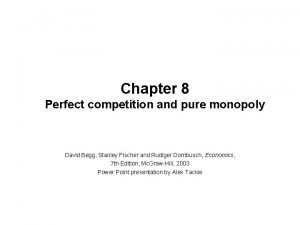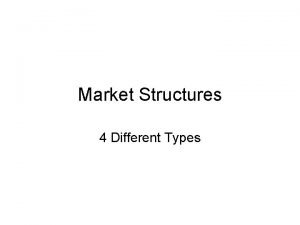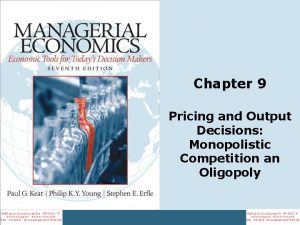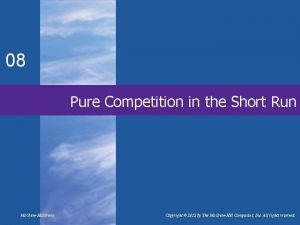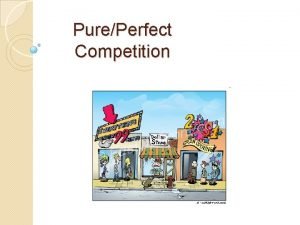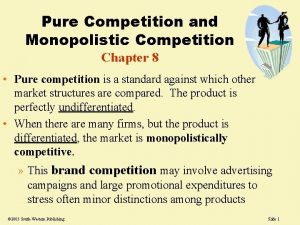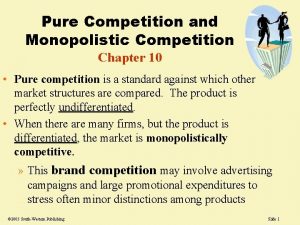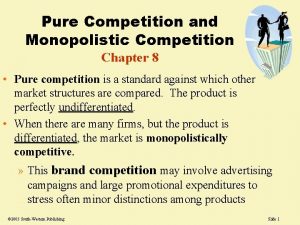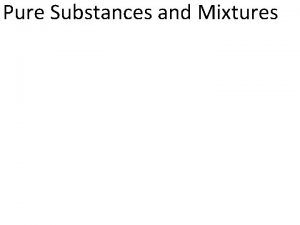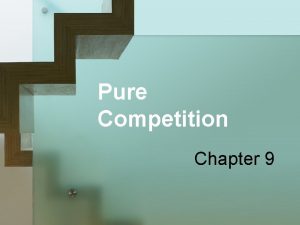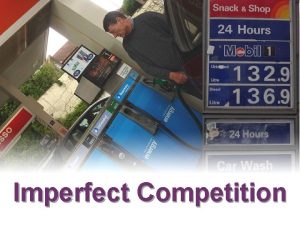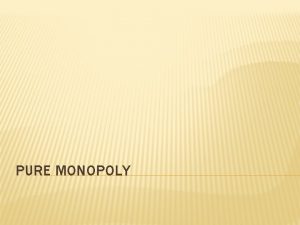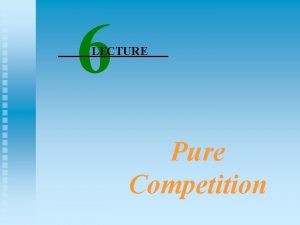Pure Competition Chapter 8 Characteristics of Pure Competition












- Slides: 12

Pure Competition Chapter 8

Characteristics of Pure Competition 1. Many sellers in large markets – farm commodities 2. Standardized Product consumers are indifferent about who produced the product 3. Price Takers – firms have no control of price 4. Free Entry and Exit – no significant barriers prevent firms from entering or exiting the market

Demand for a Purely Competitive Seller Perfectly Elastic Demand (for the individual firm) The firm can not get a higher price by restricting output. The influence of one firm on total supply and market price are negligible. Graph

Average, Total, and Marginal Revenue AR (per unit revenue) = price TR = P x Q or AR x Q MR = change in TR that results from selling one more unit of output. Because price is constant in perfect comp. , MR is constant MR=P=AR

Profit Maximization in the Short Run The purely competitive firm can maximize profit only by adjusting output. It has no control of price Economic Profit = TR-TC Graph

Marginal Revenue – Marginal Cost Approach Any unit whose MR exceeds its MC should be produced MR=MC rule: In the short run the firm will maximize profit by producing that output where MR=MC. This rule applies to all firms. Because P=MR in pure competition we can restate the rule as P=MC Graph:

Loss Minimimzation The firm will produce at a loss when the firm’s total loss is less than total fixed costs. Wherever price (MR) exceeds AVC the firm can pay their variable costs and at least part of their fixed costs. Graph

Shutdown If AVC is greater than price at all levels of output the firm should not produce. Graph

Marginal Cost and Short Run Supply Curve – the portion of the MC curve lying above its AVC Supply Curve Shifts – Changes in prices of variable inputs or technology cause MC to change and shift. Graph

Industry vs Firm The Industry demand curve is down sloping while the firm demand curve is perfectly elastic The firm “takes” the market price determined from the industry graph Graph

Long Run Equilibrium After long run adjustments are complete, product price will be exactly equal to, and production will occur at, each firm’s minimum ATC The entry of new firms into an industry eliminates profit while the exit of firms eliminates loss Graph

Pure Competition and Efficiency A purely competitive market in long run equilibrium is economically efficient Two characteristics required to be economically efficient Productive Efficiency: P = min ATC Allocative Efficiency: P=MC P reflects the marginal benefit of a good while MC reflects an opportunity cost. P > MC = underallocation of resources to that good P < MC = overallocation of resources to that good P=MC = efficient allocation – this is what consumers want The “invisible hand” keeps the economy working eficiently
 Market structure venn diagram
Market structure venn diagram Characteristics of pure competition
Characteristics of pure competition Characteristics of pure competition
Characteristics of pure competition Monopoly characteristics
Monopoly characteristics Perfect competition vs monopolistic competition
Perfect competition vs monopolistic competition Competition refers to
Competition refers to Pure competition market
Pure competition market Perfect competition examples
Perfect competition examples Perfect/pure competition definition
Perfect/pure competition definition Example of pure competition
Example of pure competition What is pure competition?
What is pure competition? Pure competition
Pure competition Pure competition examples
Pure competition examples

